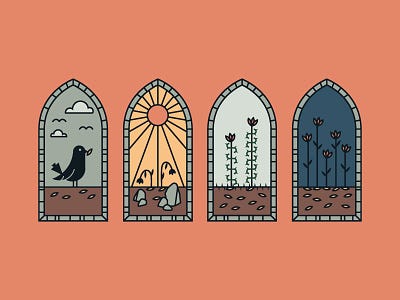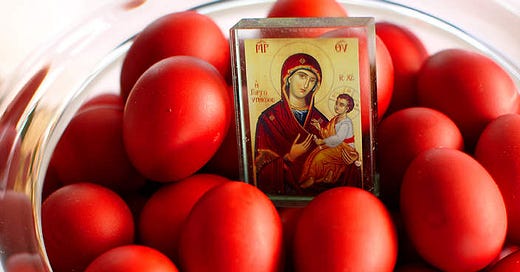Dear Friends,
Alleluia, Christ is Risen!
He is Risen Indeed! Alleluia!
As it’s so important to remember, it’s still Easter, friends. Indeed, for our Eastern Orthodox siblings, Easter has only just begun!
Every so often I find myself at least starting this note to you all from somewhere else – by which I mean, not my actual office, my “office” (aka the beat up armchair at the dining room table in front of a bookshelf where I take my meetings and pile stuff up at home), or maybe the train on my long commutes. And, usually, if I am writing from somewhere else and haven’t taken time off because I’m at a conference or something of the sort, it means I’m waiting for a medical appointment.
All of this is to say that today’s newsletter is brought to you my the Longwood Medical Area, the stretch of blocks in Boston where multiple major hospitals converge so that you can cross quickly between Beth Israel, Boston Children’s, Brigham & Women’s, and other critical medical care centers. It’s also brought to you by New England’s version of spring – a chilly breeze through the patio outside a pick-up only coffee shop amidst the hospitals, where everything is still a bit damp with yesterday’s rain.
Despite the remaining chill on the air, the ongoing threat of frost (it can drop to 39º overnight here through the end of the month), I’m reaching for that new spring life. On Friday, we went to the local garden center for two tomato starts, and we’re begging the rabbits in our yard not to eat them. My church school teachers traded notes on their gardens, about grubs and ground cover. As much as I get itchy just walking through the plant nursery, as I dose increased antihistamines to fight the symptoms of the season, I am being reminded that we are built for nature – which is why I was delighted to stumble upon this article from BioLogos, “When Children Wonder About Creation.”
Don’t we all wonder so greatly about nature, about the tree’s and the birds, about the swiftly changing world around us that is so hard to grasp, yet so wonderful to witness?
What stories can we tell to help us relish in nature, and draw closer to it?
“The Sea Is His For He Made It”
The Psalms, I think, are one of the richest sources of praise for creation, and one of the first verses that comes to mind is Psalm 96, which begins “Sing to the Lord a new song; sing to the Lord, all the earth,” and later continues –
Let the heavens rejoice and let the earth be glad;
let the sea thunder and all that is in it;
Let the fields be joyful and all that is in them;
let all the trees of the wood shout for joy before the Lord. (Psalm 96:11-12)
All of Creation lives under God’s watchful eye, even the grasses the rabbits eat in my yard, even Neil the Seal, the terror of a Tasmanian town. (If you don’t know about Neil the Seal, you’re missing out; he has his own Wikipedia page.)
I keep coming back to a conversation I’ve mentioned here, one that arose earlier this year among Godly Play colleagues. Our young people are concerned about the environment. Ecological precarity is at the front of their and our consciousness. How do we speak to and wonder about those issues? What stories do we need? The Psalms lead us to rejoice in nature, but how do we mourn it and reconnect with the world around us at the same time?
Certainly there is the Ark & the Flood. There’s something about the Passover Plagues that certainly seems relevant. Jonah’s trials with the whale, while not inherently environmental, might speak to the strange and troubled ways ecological changes have impacted human-animal interactions. The Parable of the Sower, the seeds scorched on the dry ground, offers us a New Testament entry point.

What other Bible stories or perhaps stories of saints and holy people might you tell to grapple with these worries?
And, if you’re trying to navigate this topic with your own young people or those in your community, a few great resources include:
Your Guide to Talking With Kids of All Ages About Climate Change from the National Resource Defense Council: This article gives an age by age breakdown exploring how we can talk about our relationship to the environment, the science of climate change, and good environmental stewardship, from birth through the teen years. It takes the approach commonly used for talking about other complex topics, like drugs and consent – that these are things to talk about early and often and topics that grow with your child.
Kids and Climate Anxiety from the Child Mind Institute: I love the Child Mind Institute’s work and as someone with clinical black-and-white thinking habits, this article offers excellent support on navigating the difference between normal anxiety in the face of the legitimate dangers of climate change and pathological anxiety and obsessive-compulsive disorder symptoms. The reality is that we all experience anxiety, but when it makes it hard to navigate daily life or creates unmanageable rigidity, more support is needed.
Take Action: Our churches, neighborhoods, and schools all offer opportunities to engage in practical creation care strategies. Does your church have solar panels? Can you start a recycling initiative for otherwise hard-to-dispose-of products? (Ask me about the years my mom was our church’s Terracycle hub.) Looking to the aforementioned BioLogos article, we also can’t overestimate simply making more space to engage with the natural world in ordinary ways, like tending to a garden or learning to compost.
“Why Are You Looking Up Into The Sky?”
This Thursday is the Feast of the Ascension and this pondering about the environment leads me to the line in the Godly Play story, Knowing Jesus In A New Way, that follows Jesus’s Ascension. Figures appear to the disciples who are looking up in wonder and confusion and ask, “Why are you looking up into the sky?”
Why, indeed!
Looking up into the sky is the ultimate daydreaming gesture, but what the Disciples have just witnessed was so real – and so inexplicable. And what was to come – that too, would be so strange as to seem like a dream. Pentecost, less than two weeks away, will be similar, with people thinking the newly transformed Apostles drunk early in the morning. How could they explain something that seems impossible? What could they say?
As I imagine these scenes, I am inspired by one of my favorite TikTok undertakings – a high school ceramics teacher who has partnered with younger grades to transform children’s drawings of creatures into sculptures made by her older students – to offer you an intergenerational game of creative communication for these strange times of the Church Year. If you’re having a Pentecost party, this could be an excellent activity:
Divide into three groups: the inventors/creators, the describers, and the re-creators. Mix up the ages across the groups.
The first group will draw a creature or an imaginary invention of their choosing. If you need inspiration, you might draw on a list of strange inventions or unusual animals.
The describers then have the task of interpreting this made up drawing in words or with gestures to the re-creators, who must try to draw the original subject being described. For an extra twist, you might make them build it from play-doh or clay instead of drawing it.
This activity opens us to a whole set of questions about our received stories: Iwonder, if this is what it was like to try to communicate just a single image, no matter how strange or silly, how hard it was for the first followers of Jesus or those who were part of those first miracle scenes to describe what they had been part of to other people? I wonder how that has shaped what we know and believe about what Jesus was like?
Resource Round-Up
A few things for Pentecost and general goings on in the Christian Ed space -
Pentecost Prep: Make sure you’re ready for Pentecost with the essentials, like The Day When God Made Church by Rebecca McLeod Hutto, Josey Johnson’s Hair and the Holy Spirit by Esau McCauley, and the Illustrated Ministry Pentecost Coloring freebie.
Of course it’s never a bad time for some Taize – Veni Sancte Spiritus (Come Holy Spirit) is always a great song to sing and teach for Pentecost. For background listening, you might also want something like Spirit Move! on hand -
Program & Training Opportunity: StoryMakers, a fabulous program, has got a Lilly Grant and they’re forming program cohorts! If you’re looking for new ways to serve your community while providing helpful feedback on their materials, go find out more about their program. I’d highly recommend this to communities that are trying to figure out how to meet the needs of their older children and youth – I’m really impressed by the materials they’re producing in the youth space.
On Internet Discourse: I hope most of you aren’t lost in the abyss of Twitter/X church discourse, but the reality is that I, at minimum, duck in and out of it. This week there was – I’ll say it – a bad take about where people sit in church, claiming that childless people who sit on the aisle so that families with children are stuck in the middle are being rude. As a childless adult who frequently finds herself sitting with children, it’s only rude if you’re glaring at the children for existing! Or at the adults with them for, I dunno, having children!
Anyway, if this is hitting home as reflecting challenges in the pews where you are, a reminder that I make pew cards that are meant to help non-parents/caregivers support families with children in the pews. It’s a way of signaling to your entire community that children belong in worship and are full parts of the community and that their care is all of our responsibility. Le the little children come unto me, Jesus said. That includes sharing space with them in worship, just as they are.
What else would help your community thrive right now?
Right now, I just need some more coffee and an open window. God is close at hand. Invite God into the work.
Peace,
Bird




